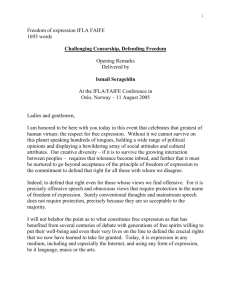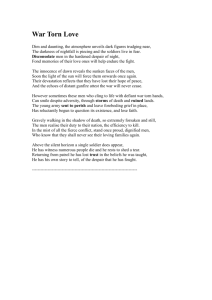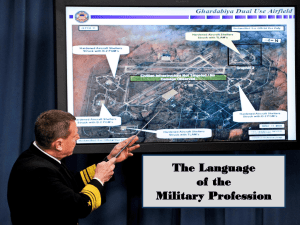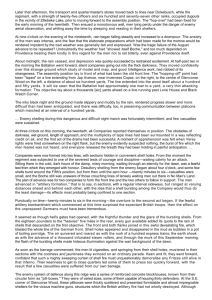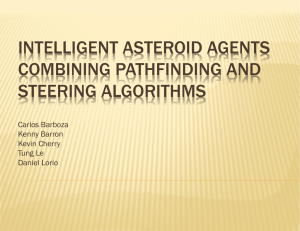The Image of the Enemy and the Process of Change
advertisement
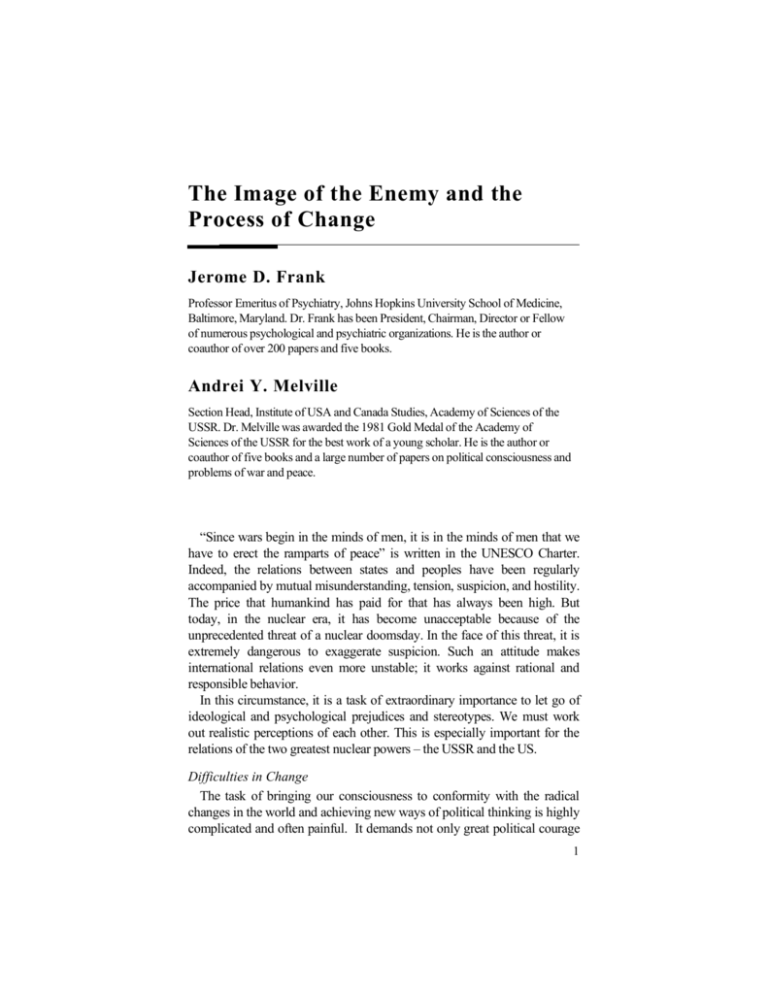
The Image of the Enemy and the Process of Change Jerome D. Frank Professor Emeritus of Psychiatry, Johns Hopkins University School of Medicine, Baltimore, Maryland. Dr. Frank has been President, Chairman, Director or Fellow of numerous psychological and psychiatric organizations. He is the author or coauthor of over 200 papers and five books. Andrei Y. Melville Section Head, Institute of USA and Canada Studies, Academy of Sciences of the USSR. Dr. Melville was awarded the 1981 Gold Medal of the Academy of Sciences of the USSR for the best work of a young scholar. He is the author or coauthor of five books and a large number of papers on political consciousness and problems of war and peace. “Since wars begin in the minds of men, it is in the minds of men that we have to erect the ramparts of peace” is written in the UNESCO Charter. Indeed, the relations between states and peoples have been regularly accompanied by mutual misunderstanding, tension, suspicion, and hostility. The price that humankind has paid for that has always been high. But today, in the nuclear era, it has become unacceptable because of the unprecedented threat of a nuclear doomsday. In the face of this threat, it is extremely dangerous to exaggerate suspicion. Such an attitude makes international relations even more unstable; it works against rational and responsible behavior. In this circumstance, it is a task of extraordinary importance to let go of ideological and psychological prejudices and stereotypes. We must work out realistic perceptions of each other. This is especially important for the relations of the two greatest nuclear powers – the USSR and the US. Difficulties in Change The task of bringing our consciousness to conformity with the radical changes in the world and achieving new ways of political thinking is highly complicated and often painful. It demands not only great political courage 1 2 / Process of Change but also certain emotional readiness. It is a task made difficult by many of our traditions and norms from the past. Difficulties arise not only from the fact that there are “visible” political and ideological obstacles, but also “invisible” psychological and emotional barriers. Traditional thinking naturally attempts to exclude painful and traumatizing new information. Psychological defenses permit one to operate with familiar and habitual concepts. They provide protection from rigorous intellectual engagement with the outstanding reality of the nuclear age: mutual vulnerability. In the past, major causes of war were efforts of rival tribes or nations to gain control over tangible resources such as territory, national resources, or human labor. The two chief rivals on the world scene today - the USSR and the US - do not covet any tangible resources possessed by the other. Instead, their conflict, which poses a massive threat to the continuance of civilization, if not humanity itself, is over which of the two political and socioeconomic systems will prevail. In such a conflict, ideological clashes, mutual perceptions, and misperceptions assume much greater importance than disputes over material assets. Many of these determinants are aspects of what has been termed the image of the enemy – a phenomenon displayed by almost all antagonistic groups. (1) The Image of the Enemy For humans as for all social creatures, the group, not the individual, is the unit of survival. Humans can survive only as members of organized groups. Groups provide protection against hostile environments and external enemies, and also provide a sense of psychological security. Since the majority of a group’s members share the same customs and norms, they can readily understand each other’s behavior, and the group carries the values that give meaning and significance to their lives. A threat to the group’s integrity, especially when posed by a group with a different worldview, strikes at the very basis of its members’ psychological as well as biological survival. Many people experience the thought of submission to an alien ideology and social system as more intolerable than death itself, a major reason for the escalation of wars. Hence humans share with all social animals the predisposition to fear and distrust members of groups other than their own. When two groups compete for the same goal, this distrust often rapidly escalates into the mutual perception of each other as enemies. Mirror Images The perceptions of the enemy very often tend to mirror each other – that is, each side attributes the same virtues to itself and the same vices to the The Image of the Enemy and the Process of Change / 3 enemy. We could find people on both sides of the East-West conflict whose images are in many aspects identical, as illustrated by the American film Rambo and the Soviet film Solitary Mission. In each case, “we” are trustworthy, peace-loving, honorable, and humanitarian; “they” are treacherous, warlike, and cruel. In 1942, when Germany and Japan were enemies of the United States, the first five adjectives used by Americans in public opinion surveys to describe the enemies included warlike, treacherous, and cruel. None of these words appeared among the first five describing the Soviets, who at that time were allies of the United States. In 1966, when the Soviet Union was no longer an ally, among the first five adjectives describing the Soviets were warlike and treacherous. These adjectives also were applied to the Chinese, but had disappeared from the lists of adjectives applied to the Germans and Japanese, who by then were allies of the United States. (2) “. . . ‘we’ are trustworthy, peace-loving, honorable, and humanitarian; ‘they’ are treacherous, warlike, and cruel.” One should also note that enemy images are not monolithic – there are variations. For example, it is often said that “the people are good; it is only the leaders who are evil.” It is much easier to hate a few evil leaders than all those people. This view may create a false hope that if somehow people could only get rid of a few evil leaders, then the problem would be solved. In fact, the problem is much more complex than that. In addition, whether it is the leaders or the people who are subject to the enemy images, the effects in either case on perception, feelings, and behavior are similar and the distinction is largely irrelevant. Ways of Thinking A key issue is the degree and type of thinking that has decisive influence on the formation of the policy of the state. A derogatory political cartoon is a symptom of an underlying attitude and a statement by a leader of the country officially endorsing the attitude is even more serious. While the ripple effects of the latter are greater, in fact, the two are mutually reinforcing, and one is probably not possible without the other. It is important for the public to be aware of each, and to be able to distinguish old thinking from new wherever it is found. New ways of thinking, new morality, and new psychology lie in a dimension outside the traditional, accepted opposition between classes and social systems. The old ways of thinking emphasize divergent and even contrary social and political content, but new thinking strives for synthesis 4 / Process of Change on the basis of common values. New thinking enables groups to unite rather than fight. The enemy image impedes resolution of group conflicts in several ways. First, under the influence of mutual enmity, adversaries acquire the evil characteristics they attribute to each other; that is, the enemy image is a self-fulfilling prophecy. In combating what each perceives to be the other’s cruelty and treachery, each may become more cruel and treacherous itself. This characteristic has its roots in societal evolution; nations that failed to recognize that their enemies were treacherous and warlike did not survive long. There was survival value in matching the tactics of the opponent, at least in the short run. Disruption of Communication While the image of the enemy once may have served an evolutionary purpose, it always has had serious negative effects. Escalation of enemy images profoundly disrupts communication. It isn’t pleasant to communicate with persons one dislikes, and, since enemies can be treacherous, they may use communication for purposes of deception. In most societies, a common way of punishing children is to refuse to speak to them, and breaking off communication remains a way of expressing displeasure among adults. However, disruption of communication between adversaries reduces the chances of discovering areas of agreement or common interests. These enemy images also act like distorting lenses that magnify confirming information and filter out incompatible information. This, in turn, increases the likelihood of serious misunderstandings of the enemy’s intentions. Thus the mass media in both the USSR and the US often play up incidents which were regarded as manifestations of the other’s treachery or cruelty and tended to ignore examples of humanitarian or honorable behavior. Similarly, the same behavior is often seen in the service of good motives if performed by one side and in the service of bad motives if performed by the other side. For example, although in wartime both sides always commit atrocities, the enemy’s atrocities are evidence of his evil nature, whereas ours are portrayed as regrettable necessities. Dehumanization As the mutual formation of the image of the enemy develops, the adversary is progressively dehumanized. Members of hostile groups see each other as bestial and subhuman on the one hand, and diabolically clever on the other. In either case, this perception seriously weakens inhibitions humans may possess against attacking fellow humans. Destroying vermin or devils becomes a praiseworthy, even holy activity. The Image of the Enemy and the Process of Change / 5 All this can progress to the point where the enemy is perceived as literally demonic, that is, as totally evil. If the enemy is viewed as the incarnation of evil, then whatever it perceives to be in its interest must by definition be disadvantageous to us. (“It” is an object; “we” are human.) In many cases, for example, the mere fact that either of the superpowers offered a proposal for arms control was sufficient to cause the other to reject the proposal out of hand. The “zero option” proposal for intermediate nuclear missiles in Europe is illustrative. Proposed by the US in 1981, it was at first rejected by the USSR. Later, repackaged, but offered in a substantially similar form by the USSR, it was at first rejected by the US. “A universal feature of the enemy image is that the enemy can be influenced only by force.” The image of the enemy tends to impoverish each nation’s own self-image in that each is tempted to define itself primarily as the opposite of its enemy. That is, the image encourages ideological rigidity and a self-image that is monolithic, lacking in depth and complexity, and not in keeping with reality. Therefore, transcending the image of the enemy inevitably requires rising to a new level of political thinking. ‘Enemy’ as Justification for the Arms Race Furthermore, because of a human desire for consistency, whatever the enemy does is used to confirm the correctness of one’s own behavior. A universal feature of the enemy image is that the enemy can be influenced only by force. If the enemy resists the effort to apply force, our side must double its efforts. If, on the other hand, the enemy seeks conciliation or compromise, this is a sign that force is having an effect. Alternatively, the enemy’s conciliatory moves are seen as efforts to weaken one’s own determination. In either case, conciliatory acts become justification to intensify the pressure. The enemy phenomenon is a powerful driver of the arms race and, ultimately, towards war. There is a vicious circle. Arms races are the source of misconceptions and stereotypes. The atmosphere of militarism and preparation for war is an ideal medium for the emergence and confirmation of evil images. Further, in the nuclear age, absolute weapons need absolute enemies. As a result, the arms race and image of the enemy feed off each other in an upward spiral. This interconnection means only one thing: Disarmament is impossible without fundamental changes in the psychology of international relations, and it is also impossible to get rid of the image of the enemy without stopping the arms race. That is why relaxation of tension, overcoming the 6 / Process of Change image of the enemy and hostility, and establishing a basic trust between countries and nations are tasks as important as disarmament. They are among the main components for building up a new way of political thinking. The struggle against the threat of a nuclear holocaust demands a struggle against the ideology of hostility, demonology, and against the legitimation of the image of the enemy with the help of the rhetoric of “just wars.” To win this struggle demands reorientation of the psychology of international relations itself. Internal Implications The image of the enemy is not only very dangerous for the stability and security of international relations but leads to highly negative consequences for the domestic life of countries. This happens because the hysteria about the outer threat is often used as justification for secrecy and suspicion, covert actions, policies creating “mobilized” societies, artificial national unity, “witch hunts,” and policies suppressing dissent, all ignoring domestic problems and distracting attention from them. By projecting the blame for these on the enemy, each side protects its own self-esteem from the realization that it has been unable to solve its own problems. “. . . hysteria about the outer threat is often used as justification for secrecy and suspicion, covert actions . . . and policies suppressing dissent. . .” Changing Images Meanwhile, a hopeful consideration is that people can change with remarkable speed from enemies to friends, despite the apparent intractability of enemy images. This can occur when they decide that cooperation yields vastly greater benefits to both than antagonism. A most encouraging recent case in point is the rapid change in American perceptions of mainland China. According to public polls in the United States in 1976, three-quarters of the American public saw China as a hostile power. Only six years later, in 1982, the same percentage saw China as a friendly power and close ally, even though the Chinese leaders, like the Soviet ones, remained faithful to communism. (3) Realistic understanding of the real doubts and problems of the other side may well be one of the ways to overcome the image of the enemy. Such understanding doesn’t eliminate the differences or solve problems and contradictions, but enhances the possibility of finding compromise solutions. It demands an obligatory condition of maximum possible truth in The Image of the Enemy and the Process of Change / 7 depicting the other side and oneself, free access to information, without distortion or secrecy. For this effort, one needs political courage and psychological preparedness. This realistic approach is the starting point for transcending the image of the enemy. Specific Requirements for Change Two essential requirements for progressing to a world beyond war are to inhibit the formation of the reciprocal images of the enemy by antagonistic groups, and to inhibit antagonists from resorting to violence as a way of responding to the fear and frustrations created by images of the enemy. To consider the second aim first, creating effective means for determining the outcome of disputes depends on the commitment to renounce violence in resolving international conflict. This commitment in turn must begin with the transformation of attitudes and values of individuals. Specifically, the precepts underlying nonviolent actions demand that its adherents acknowledge that their opponents share a common humanity and are activated by motives which in their own eyes are often regarded as just. That such a massive inner transformation is somewhat rare, that its emergence cannot be predicted, and that its successes have usually been sporadic and temporary must be acknowledged. On the other hand, history supplies many examples of the enormous power of nonviolent actions, such as the examples in modern times of Leo Tolstoy, Mohandas Gandhi, Martin Luther King, and others. New Technologies The ability to progress beyond war around the world is greatly facilitated by new technologies equally as revolutionary as nuclear weapons. These technologies provide powerful means for heightening awareness of worldwide threats posed by nuclear weapons, for reducing national antagonisms, and above all, for fostering cooperation. At least three new technologies are useful for achieving these ends: international telecommunication by satellite; international rapid mass travel; and exploration of outer space. With respect to the first, national leaders already use the hotline and surveillance satellites to communicate rapidly and directly without the distorting effects of intermediaries. This may reduce mutual fears by imposing restraints on secret preparation for hostilities. Television and radio are by far the most effective means of communication ever invented. In contrast to the printed word, they jump the illiteracy barrier and have immediate and powerful emotional impact. Today, through television receivers in public places and transistor radios in the hands of individuals, communication satellites are already capable of 8 / Process of Change reaching a significant fraction of the world’s population. (4) The possibilities of international satellite communications are limitless for driving home on a worldwide scale the menace of nuclear weapons and promoting mutual – and more realistic – appreciation among the world’s people. Television spacebridges such as those which have several times now occurred between Moscow and various American cities provide a glimpse of what the future holds. Another technical innovation, rapid mass air transportation, can be used to bring a wide representation from different countries together in face-toface interaction with each other. Some such programs are already operative, especially at the high school level, and they easily could be vastly expanded. That the official policies of both the US and the USSR now encourage exchanges of scientists and artists as well as students is heartening. “The threat of nuclear annihilation should be useful to draw nations together.” To be realistic, increased communication, while a prerequisite for increased mutual understanding, does not automatically have this effect. It sometimes intensifies mutual hostile stereotypes. At the same time, there is abundant information confirming that interaction much more often results in mutual appreciation than hostility and mistrust. (5) Superordinate Goals A powerful way of breaking down enmity between groups and encouraging them to work together is to create goals that can only be reached by cooperation between them. The power of this approach has been illustrated by a classic sociological experiment at a boys’ camp in which the mutual hostility of two rival groups was overcome when they had to cooperate to achieve goals that both wanted but neither could achieve alone. (6) There are similar “superordinate goals” at the international level that could promote cooperative attitudes among nations and combat hostile ones. The most obvious one is survival - a goal surely shared by all nations and one increasingly jeopardized by the nuclear arms race. The threat of nuclear annihilation should be useful to draw nations together. Unfortunately, in contrast to the boys’ camp, where joint measures for survival did not weaken either group, international measures for survival in the long run are perceived as jeopardizing survival in the short run. All nations want to survive and recognize that nuclear disarmament is necessary to achieve this goal, but none is willing to risk the radical unilateral measures necessary to get the disarmament process started. The Image of the Enemy and the Process of Change / 9 Modern scientific and technological advances have created potential international enterprises that would not threaten the security of any nation, and nations working together on these projects would achieve much greater rewards than any one nation could attain alone. At the international level, a spectacular confirmation of this may be the treaty about demilitarizing the Antarctic, and providing the cooperative exploration of the Earth’s crust and oceans. (7) This treaty is self-enforcing. It is to each nation’s interest not to violate it, because the gains from respecting the treaty’s provisions outweigh the gains that might result from each nation attempting to militarize its own zone. Other recent examples of successful international cooperation to achieve superordinate goals are the cleaning up of the Mediterranean and the worldwide eradication of smallpox. Superordinate goals that urgently require immediate international cooperation are checking pollution of the atmosphere and oceans and halting the ominous destruction of the ozone layer. Special mention should be made of outer space. While outer space tends to become a particularly dangerous arena of conflict, it also provides magnificent opportunities for international cooperation on projects that require resources that tax the facilities of even the wealthiest of nations, such as the Apollo-Soyuz space program. Outer space has the additional advantage of providing a positive outlet for the nobler martial virtues such as heroism and self-sacrifice. Since such activities potentially yield enormous benefits to all parties involved, they can be expected to increase. Since prolonged participation in international cooperative ventures is incompatible with maintenance of mutual images of the enemy, these ventures provide the best immediate hope for freeing nations from the thrall of this image, thereby diminishing the threat of nuclear holocaust. In the nuclear age, there must be a guard against old ways of thinking dominated by the image of the enemy, and a search for new ways of thinking based on the priorities of shared humanity, beyond class, political, and ideological differences. Conclusion The arms race is not driven by weapons alone. It is also driven by a very simple psychological phenomenon, the image of the enemy. Weapons of total destruction would be useless without such images. For such weapons to have any purpose, there must be people who may be totally destroyed. Adversaries must be transformed into demons. Once such images have been created, they, in turn, drive the arms race. People resist giving them up. There is a desire to see everything in a light which will reinforce the image. Images foster closed minds and reinforce resistance to change. 10 / Process of Change But change is possible. It has happened many times in history. Whole peoples have changed their views of one another. Even between the superpowers, areas of special accommodation have been achieved, agreements have been followed. New technologies offer new potentials for communication. New goals which transcend the narrow national interests of each will offer a framework for future common actions. In working out the way to achieve those goals the enemy images can be gradually lessened, perhaps even dissolved. If humankind is to survive in the nuclear age, there must be progress in this direction. References 1. Sam Keen, Faces of the Enemy: Reflections of the Hostile Imagination (San Francisco: Harper and Row, 1986). 2. Gallup Poll: Public Opinion, 1959-1971, Vol. III (New York: Random House, 1972), p. 2015. 3. Jamie Kalven, “A Talk with Louis Harris,” Bulletin of the Atomic Scientists, Vol. 38 No. 7 (September 1982), pp. 3-5. 4. I. Ahmad and J. Hasmi, World Peace through Improved Perception and Understanding. Proceedings of the Thirty-Second Pugwash Conference on Science and World Affairs. Warsaw, Poland, August 26-31, 1982 (Basingstoke, England: Taylor & Francis, 1982). 5. Herbert C. Kelman, ed., International Behavior. A Sociopsychological Analysis (New York: Holt, Rinehart & Winston, 1965). 6. Muzafer Sherif and Carolyn W. Sherif, In Common Predicament: Social Psychology of Intergroup Conflict and Cooperation (Boston: Houghton Mifflin, 1966). 7. Deborah Shapley, “Pax Antarctica,” Bulletin of the Atomic Scientists, Vol. 40 No. 6 (June-July 1984), pp. 30-33. 11

